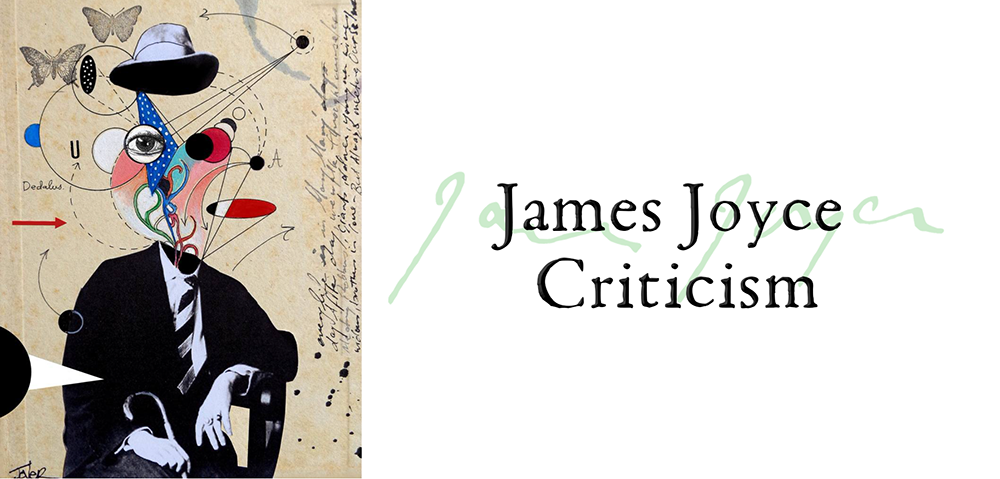Joyce Criticism: “Finnegans Wake” 5. Independents
- At January 06, 2022
- By Great Quail
- In Joyce
 0
0
Finnegans Wake: Independent Criticism
Like Freemasonry and the “real” meaning of Gravity’s Rainbow, Finnegans Wake moves many people to self-publish. Some of them even do it on the Web! The following books are “independent.” This is not to dismiss them as the work of crackpots; some appear quite lucid and well-written. However, few of the following books have been professionally edited or peer-reviewed. The books are listed by publication date. Clicking a cover image takes you to Amazon.com. When Brazen Head commentary is unavailable, the publisher’s summaries are usually reprinted. If any knowledgeable Joyce reader would like to review, summarize, or provide additional information for any of these “uncommented” books, please drop us a line! Additional Wake criticism may be found by clicking the links below:
Finnegans Wake Criticism
[Main Page | Guides & Annotations | Criticism 1929-1999 | Criticism 2000-Present | About the Wake | Independent]
A Word In Your Ear: How & Why to Read James Joyce’s Finnegans Wake
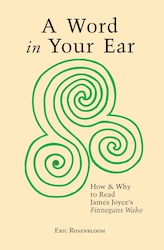
A Word In Your Ear: How & Why to Read James Joyce’s Finnegans Wake
By Eric Rosenbloom
BookSurge Publishing, 2005
Publisher’s Description: Whether you’re new to Finnegans Wake or a long familiar friend, this lively and readable essay will guide, refresh, and delight. The author provides essential background information and helpful reading techniques while conveying the pleasures of delving into Joyce’s dense text.
The Conundrum of Language: Difficulties of Reading and Language in James Joyce’s Finnegans Wake
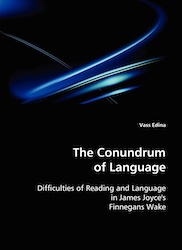
The Conundrum of Language: Difficulties of Reading and Language in James Joyce’s Finnegans Wake
By Vass Edina
VDM Verlag Dr. Müller, 2008
Author’s Description: Almost every piece of criticism concerning Finnegans Wake describes it as a difficult or unreadable work. Therefore, considering the above statement as starting point, throughout the book I analyzed the role of the reader and revealed the reading difficulties caused by the unconventional novel. I shed light on how the book relates to conventions and the changes generated, as a result, in the attitude of the reader. Finnegans Wake changes our entire concept of language, thus a central theme of the book is Joyce’s special usage of language developed to the level of mastery. Readers often doubt even the mere existence of any meaningful language within the novel. However, it is worth noting that instead of imposing any kind of limitation, it broadens the borders. One should rely on the comfort and enjoy the humor provided by the novel rather than fear it.
A Finnegans Wake Lextionary: Let James Joyce Jazz Up Your Voca(l)bulary
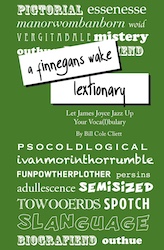
A Finnegans Wake Lextionary: Let James Joyce Jazz Up Your Voca(l)bulary
By Bill Cole Cliett
CreateSpace Independent Publishing Platform, 2011
Publisher’s Description: Finnegans Wake is most definitely a deliberately difficult book, complex, complicated, obscure. The reasons for this are diverse, but an important cause is Joyce’s capacity for creating his brave new work from thousands of bold new words. They are creative collisions of existing words, concocted collaborations of multilingual words, and combinations of both that are the inception of a comprehensive, catholic language all its own, what is generally referred to as Wakese. A Finnegans Wake Lextionary introduces readers to over 800 of these offbeat, bizarre, weird, and way out words, words well outside our dictionaries, that exist in a literary “langscape” all their own. And since Joyce meant for his inventions to contain multiple meanings evocative with elusive allusions, the definitions given here are only the jump-off point for lots more fun with Finnegans Wake.
Riverrun to Livvy: Lots of Fun Reading the First Page of James Joyce’s Finnegans Wake
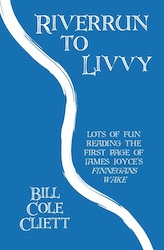
Riverrun to Livvy: Lots of Fun Reading the First Page of James Joyce’s Finnegans Wake
By Bill Cole Cliett
CreateSpace Independent Publishing Platform, 2011
Publisher’s Description: Finnegans Wake is the most deliberately obscure and difficult work in literature. Readers are over their heads and struggling for shore by the second sentence. The Wake is often described as unreadable, and that’s not entirely unfair given the book’s setting in the dark night of the subconscious and dreams where strange shapes shift and merge in a multitude of motifs and the fact that it’s written in mixture of many of the world’s languages now known as Wakese. Finnegans Wake refers to itself as a “nightmaze,” something readers translate as nightmare. But what seems at first sight as meaningless, actually has more meanings than can be imagined, and what appears as unreadable requires only a radically new look at what words can be made to do. Riverrun to Livvy is a literary layman’s attempt to enlighten Joyce’s “book of the dark” for a wider audience, inviting those who want to be “well letterread” on a journey into the twilight zone of literature. The first page of Finnegans Wake has been compared to the first second of the Big Bang, containing as it does all the elemental materials that compose the complete creation. Through a close reading of the Wake’s first page, Riverrun to Livvy prepares readers to tackle the remaining 627 pages with a greater degree of insight and understanding. It’s been said that no one can be considered truly educated without having read at least one page of Finnegans Wake. Riverrun to Livvy dares readers not only to pick up the gauntlet by reading one page but to boldly go where few readers have gone before, all the way through literature’s most terrifying text.
Joyce’s Finnegans Wake: The Curse of Kabbalah, Vols. 1-10
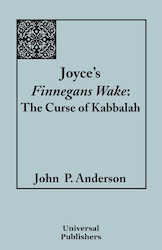
Joyce’s Finnegans Wake: The Curse of Kabbalah, Vols. 1-10
By John P. Anderson
Universal Publishers, 2008-2014
A series 10 of surprisingly high-priced chapbooks in which John P. Anderson interprets Finnegans Wake through the Qabalah. The link above takes you to the first volume; interested readers are free to search Amazon for the remaining volumes. While it’s clear that Anderson is reading the Wake through an extremely particular mindset, his writing is refreshingly direct, and he’s not without a sense of humor.
Publisher’s Description: This non-academic author presents his key to opening James Joyce’s infamously difficult and endlessly playful novel Finnegans Wake. The key was fashioned in Kabbalah, an ancient Jewish mystical tradition that as interpreted by Joyce champions independent individualism as the path to the highest spirituality. Kabbalah images a universe excreted by the ultimate god, a universe that is necessarily finite and limited that came with its own secondary god that is finite and limited, the god presented in Genesis that issues blessing and curses designed to make mankind fearful and dependent—the curse of Kabbalah. Joyce laid this curse in his dream-like “Book of the Night” in the elastic way that the latent or hidden content of a dream distorts the presentation of dream materials. Acting like a black hole, this curse pressures the main character Harold Chimpden Earwicker to “fall,” to become fearful and dependent just like everyone else, that is reduced to the mere initials HCE for “Here Comes Everybody.” Joyce traces this curse from the myths in Genesis to the primal horde, the first social organization of humans, to the Oedipal Complex and to nation state warfare such as the Battle of Waterloo. In a groundbreaking presentation, Anderson deciphers word by word the first two chapters and part of the last chapter to show how this key opens the lock. He shows, for example, how the joined ending and beginning of Joyce’s wisdom book form the Hebrew word for curse and the ending shows confrontation rather than repression of fear of death as the key to life, to your own wake.
Finnegans What? Finnegans Wake—A Guide by an Idiot
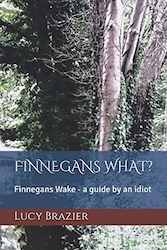
Finnegans What? Finnegans Wake—A Guide by an Idiot
By Lucy Brazier
Independently Published, 2019
Author’s Description: I read Finnegans Wake so you don’t have to! But, let me tell you now, this is no insightful academic assessment of what is perhaps the most perplexing, ambiguous and downright impenetrable work of literature known to man. One summer a couple of years ago, in-between writing my own novels of dubious quality, I fancied a bit of a literary challenge. I had participated in Bloomsday—an annual celebration of James Joyce’s other famed work, Ulysses—a few times and it struck me that maybe it was time to tackle the mighty Finnegans Wake. The idea of attempting an idiot’s guide (or, more appropriately, a guide by an idiot) came about after discussing my attempts at comprehension with friends. And so this, Finnegans What?, a plaintive effort to decipher the indecipherable, was born. My method was a to read a chapter and then make notes about what I thought might be happening. These were originally posted weekly on my blog for the benefit of curious readers. So what we have here is a chapter-by-chapter explanation, as I read each in turn. This is my interpretation and musings on Joyce’s eponymous work, rather than any kind of instructional companion or serious analysis. Goodness knows, I’m not capable of that kind of high-minded literary endeavour. I’m just an ordinary person, reading Finnegans Wake. And this is what I came up with.
Finnegan Begin Again: A New Novel Towards an Understanding of Finnegans Wake
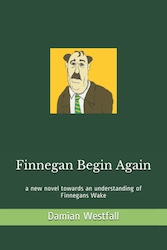
Finnegan Begin Again: A New Novel Towards an Understanding of Finnegans Wake
By Damian Westfall
Independently Published, 2019
This seems to be a novel inspired by Finnegans Wake. The only material offered by the author is an excerpt:
Mt. Kuhwahkoom! The high point of creation rising up above the sleeping valley of Walnut Creek, four thousand feet from the earth to its highest peak. You stand at the top, you look before you and behind you, you run your right hand through your hair, you clear your throat and lick your lips, and then you outstretch your arms and shout in absolute joy and abandon “Yes!” You feel then something new rising up in you from your intestines and so you go down down down the devil mountain (where the dogs came from). Down past the skeletons of Miwok and Ohlone Indians (rusted beer cans, past the plastic jerky wrappings) and the abandoned tires from which the brown weeds grow, go down down down. You run past Jurassic rocks of no value to you, down into the bay and valley of Walnut Creek, and you go out of Walnut Creek, West of Walnut Creek, past Oaktown and the plains of perpetual slavery, you vault the bridge, you go through the city’s labyrinth, merging lanes from 24 to 80 South, down through San Jose and down through Fresno and the grapevine. Swerve left off Five and up into the Rockies, up up up and swerve right and then down down down through the sodomitten San Fernando Valley, cusp of vice, and down further into San Diego proper. You kiss the whale and swerve right again at the old naval base and onto the grains of the sandy baking beaches and (Splash!) into the Pacific Ocean you dive, and down you go, under the brine and the beer cans, where blue becomes black, and down down down to the very base of the of the mountain and there you will find stillness. There where the behemoth grows fat on blind albino eels, where the treasure chests of olde have landed in their final resting places, down where the monstrously ugly and odd sea creatures float and thrive, there where the merfolk dwell, there where the ocean floor is scattered with skeletons of sailors and pirates, who still wear their giant buckled belts and two cornered befeathered hats, there were the weight of gravity and miles of ocean really begin to press down on you, there where the only sound is erratic bubbling, there you will find calm. You go down to where you cannot go down any further and then you turn and face the continental devil mountain and you begin to climb once more.
Nirvanic Finnegans Wake: James Joyce’s West/East Revelation
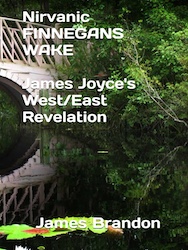
Nirvanic Finnegans Wake: James Joyce’s West/East Revelation
By James C. Brandon
Independently Published, 2021
I haven’t read this book, so I don’t know exactly what it’s about; but I’m certain the author’s description will clear things up!
Author’s Description: Joyce, man of Letters, fluent in Languages, Traveler in circles high and low and places near and far, disciplined in conscientious Mindfulness, Scholar of knowledge, Compassionate husband father and friend, Prophet to Mankind. “HCE & ALP day” similar to Bloomsday (roughly 24 hrs): Chronologically, FW starts with Aristotelian courtroom memories (travail, Bk I:3) of HCE arrested in front of his gated refuge (from MaMaLuJo’s tale) unable to enter, unlike Bloom HCE does not enter through the back door (Ulysses Ch Penelope), instead HCE is arrested in the hours before dawn. {newly incorporated dream: HCE “awakens” in jail (samsara, Bk I:1, Sisyphus’ eternity) after his dream remembrances/anamnesis of his/NC/HCE arrival & attending Finnegan’s wake at the ‘House of call’, to marry Anna/ALP & assume the pub/tavern keeper’s role (consciousness space) made available by Finnegan’s passing/transmigration years ago.} Followed by (a living death, Bk I:4) HCE’s psychological musings of past travails/guilts (underworld Hell excursion, Ulysses Ch Hades) while incarcerated in the early hours of morning, visited in jail by ALP before HCE’s courtroom trial & defense and release & liberation. HCE walks home (accusation, HCE’s/Tamas an evolving Sattva, Bk I:2) through Phoenix Park accosted for the time of day (12 noon) by the ‘cad’/rajas which threatens (real & unreal choices, Ulysses Ch Nausicaa) his innocent vico/“well-being”. Joyce rewrites 3 chapters of Ulysses to incorporate Vico’s road/revelation of restart & recirculation into FW: When He is denied Her front door, He is in Hell (on earth), when released (from Hell) His odyssey to Her begins again (with His ever-present accompanying internal travails) for She always knows when He is worthy of Her acceptance, their Paradise. HCE at his tavern/ship: He & his patrons retelling “recollections/anamnesis”, Bks I:2-4. ALP’s & their family’s history (truthful letters & gossips), Bks I:5-8. And HCE’s history, their marriage of Christian/Buddhist spiritual/sexual compassion ‘a tale of a tub’ (Norweeger Capstan & Tailor’s daughter) & the story of “how Buckley (offensive Nirvanically free-will imbued) shot the Russian General (Leviathan/Vritra)”, Bk II:3. While their children (Shaun/saint, Shem/sage & Issy) are in and out of the family pub/tavern home/ship all day taking their lessons, Bk II:2. Children playing about with their friends, Shem’s closing dream Mannagde-received, Bk II:1. HCE, as proprietor, defends himself with a self-deprecative apologia before his intoxicated collapse late night, Bk II:3. HCE’s Platonic dreams on his tavern floor, Bk II:4; then he dreams in his bed, Bks III:1-3. Then their sexual meditation: mortal bodhisattva’s commitments to the Joys & sufferings of our lives interrupted, before intercourse with his wife ALP, Bk III:4. HCE & ALP’s lovemaking sexual/spiritual dissolution dream, Joycean Nirvana is attained by ALP & HCE, Bk IV; to awaken to a new day awaiting Joyce’s God “thunderclap”, manifestation at the beginning of FW’s Bk I:1.
Joyce Criticism
[Main Page | General Criticism | Dubliners | Portrait | Ulysses | Finnegans Wake]
Author: Allen B. Ruch
Artwork: Loui Jover
Last Modified: 14 June 2024
Main Joyce Page: The Brazen Head
Contact: quail(at)shipwrecklibrary(dot)com

